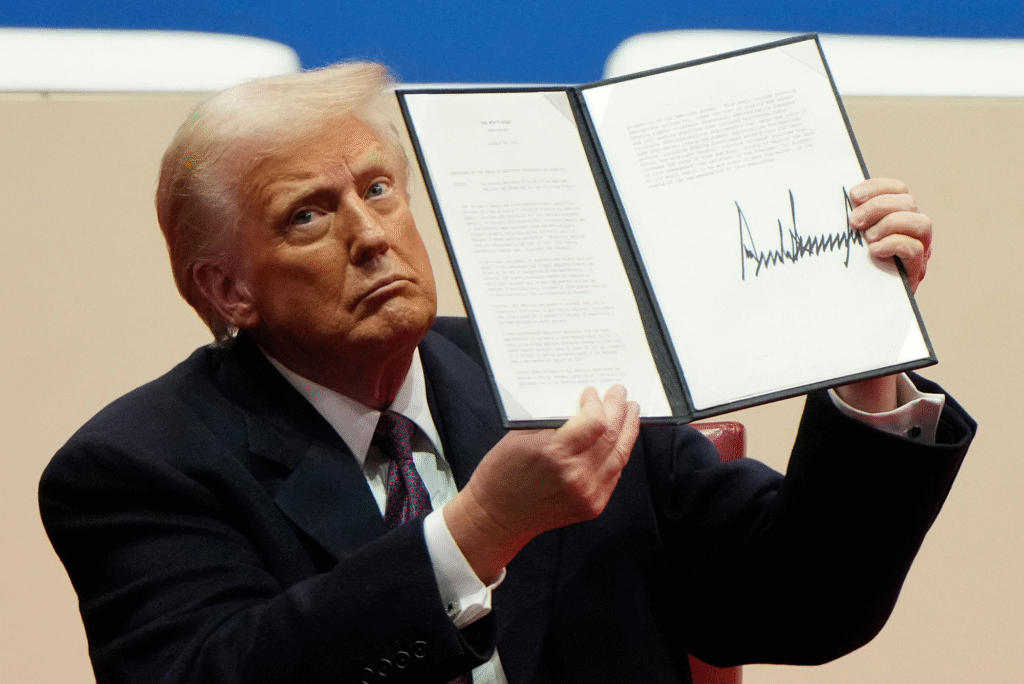WASHINGTON In a dramatic escalation of US involvement in the Ukraine conflict, President Donald Trump has announced a new NATO-enabled strategy that will send cutting-edge weapons to Kyiv. Simultaneously, he issued an ultimatum to Russia: reach a peace agreement within 50 days, or face crippling 100% secondary tariffs on all nations trading with Moscow.
“We want to make sure Ukraine can do what it wants to do,” Trump said during a joint press briefing with NATO Secretary General Mark Rutte. He emphasized the urgency of rebalancing the war in Ukraine’s favor while delivering an economic threat aimed directly at Russia’s global trade lifelines.
Rutte confirmed that European countries would send their Patriot missile defense systems to Ukraine immediately, with the United States backfilling those inventories. While neither leader specified the full arsenal involved, Rutte noted the transfer would include “missiles and ammunition,” a sign of heavy military escalation.
A Game-Changing Military Surge
According to Trump, the value of the arms package would reach billions of dollars and be “rapidly deployed to the battlefield.” This marks the first major defense commitment Trump has made toward Ukraine since returning to the Oval Office.
“If I were Vladimir Putin today, I would rethink my position,” Rutte added, suggesting the new NATO-backed effort could tilt the dynamics of the conflict significantly. Ukrainian President Volodymyr Zelensky expressed gratitude on social media after speaking with Trump, thanking him for his “willingness to support Ukraine” and pursue “a lasting and just peace.”
Economic Warfare: The 100% Tariff Plan
Perhaps even more provocative was Trump’s threat of imposing 100% secondary tariffs on any country still conducting trade with Russia, should Moscow fail to secure peace terms within 50 days.
“If you’re buying oil from Russia and want to sell your goods in the US, you’ll pay a 100% tariff,” Trump said. “We’ll make it too expensive for them to keep financing the war.”
The economic blow could be severe. With oil and gas making up over 60% of Russia’s exports and nearly a third of its state revenue, choking off that income could destabilize Moscow’s financial base. The plan targets global buyers like India and China, whose imports of Russian energy have remained robust despite Western sanctions.
Ironically, the Moscow Stock Exchange saw gains after the announcement, signaling that investors had anticipated even harsher actions. Still, Trump’s approach is anything but soft.
Shift in Tone Toward Putin
Trump’s rhetoric toward Russian President Vladimir Putin has sharpened noticeably. Once criticized for being too conciliatory, Trump now voices clear frustration.
“My conversations with him are always pleasant then the missiles launch the same night,” he said. “At some point, words mean nothing. Action matters.”
He continued, “He fooled Clinton. He fooled Bush. He fooled Obama. He fooled Biden. But he didn’t fool me.”
Despite two previous ceasefire attempts this year, further negotiations between Kyiv and Moscow remain stalled. Ukraine blames Russian intransigence, while Moscow accuses Kyiv of dragging its feet.
Support from Ukraine and NATO Leaders
Meanwhile, US envoy Keith Kellogg visited Kyiv for high-level discussions with Zelensky. The Ukrainian leader described their meeting as “productive,” expressing hope that this new initiative will shift the momentum toward peace.
NATO allies, including Germany, Sweden, and Norway, are reportedly lining up to participate in the weapons funnel, using their own stockpiles to reinforce Ukraine while replenishing through American supply chains.
Skepticism from Moscow
Predictably, Russian officials have downplayed the impact. Former Putin aide Sergei Markov dismissed the tariff threat as “a bluff,” while Senator Konstantin Kosachev said the announcement amounted to “much ado about nothing.”
Still, Kosachev admitted that much could change “on the battlefield and in political capitals” over the next 50 days.
Whether Trump’s bold combination of military reinforcement and economic coercion can push the war toward resolution remains uncertain. But one thing is clear: the US president is no longer sitting on the sidelines.
